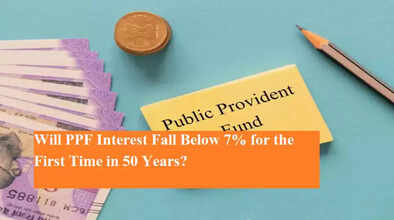Will PPF Interest Fall Below 7% for the First Time in 50 Years? Here's What It Means for Investors

PPF Interest Rate Update: Could India’s Trusted Savings Scheme Drop Below 7%? Investors Need to Stay Alert
The Public Provident Fund (PPF) has long been a cornerstone of India’s small savings schemes, offering secure returns, tax benefits, and a disciplined way to build long-term wealth. Launched in 1968, the scheme allows individuals to invest anywhere between ₹500 and ₹1.5 lakh per year with a maturity period of 15 years, extendable indefinitely in 5-year blocks.
One of the key features of the PPF is its EEE tax status—meaning investments, interest earned, and maturity amounts are all exempt from income tax. But despite its popularity, recent discussions around a potential cut in PPF interest rates have raised eyebrows—especially with speculation that the rate could dip below 7% for the first time in five decades.
Why Is a Rate Cut Being Discussed?
The possibility of a cut stems from recommendations made by the Gopinath Committee, which suggested that small savings rates, including that of the PPF, should be linked to market trends—specifically to the average yield of 10-year government bonds in the previous quarter, plus a spread of 25 basis points (bps).
For the April to June 2025 quarter, the average yield on 10-year government securities was 6.30%. According to the formula, this would imply a new PPF interest rate of 6.55% (6.30% + 0.25%). This figure is notably lower than the current 7.1% rate, sparking concerns that the government may officially announce a rate reduction in July 2025, when the next review is scheduled.
What Do Experts Say?
Despite the mathematical logic, financial experts believe the government is unlikely to let the rate fall below the symbolic 7% mark. The PPF has remained above 7% for over 50 years, and a sub-7% rate would not only be historically unprecedented but also politically sensitive, especially given that Sukanya Samriddhi Yojana and SCSS (Senior Citizen Savings Scheme) are currently offering 8.2% interest.
Lowering the PPF rate below 7% could diminish its attractiveness among middle-class savers, retirees, and long-term investors who rely on this scheme for tax-free and risk-free returns.
How Will a Rate Cut Impact Investors?
If the government decides to reduce the PPF interest rate, even marginally, it will have the following implications:
-
Lower Overall Returns: A cut from 7.1% to 6.55% may seem small, but over 15 years, it would significantly impact your maturity corpus.
-
Shift to Alternatives: Investors might start exploring other high-interest small savings schemes like Sukanya Samriddhi (for girl child) or fixed deposits, albeit with different risk and tax profiles.
-
Reduced Tax-Free Gains: Since PPF interest is tax-exempt, a lower rate means less annual tax-free income.
-
Incentive to Invest Before Rate Cut: Investors planning fresh deposits may want to do so before the new rates are implemented in July.
What Should Investors Do Now?
With the interest rate revision due in July 2025, here are a few tips:
-
Maximize Contributions Now: If you haven’t made your full ₹1.5 lakh investment for the current financial year, consider doing so before July 1, in case the new rate kicks in afterward.
-
Diversify Savings: Explore a mix of other instruments like SSY, SCSS, NPS, or tax-saving FDs to balance risk and return.
-
Monitor Government Announcements: Stay updated on official notifications from the Finance Ministry or the National Savings Institute, which will confirm any rate changes.
Key Takeaways:
-
PPF rate may dip to 6.55% based on current government bond yields.
-
Current rate is 7.1%, and many believe the government may maintain it to preserve investor trust.
-
A rate below 7% would be unprecedented since PPF’s launch in 1968.
-
Investors should prepare in advance and consider diversifying their portfolios.
As the government prepares to review interest rates in July, all eyes are on whether PPF will maintain its historic 7%+ legacy or adjust to the market-driven formula. Either way, investors would be wise to stay informed and act promptly.

